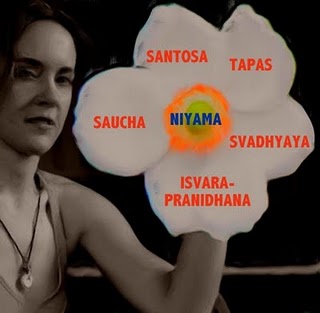Asana: Posture Practice
by Hannah Greenstreet
The third limb of Patanjali's eight limbs of yoga is asana. The Sanskrit word asana translates as the
verb “to sit”, a simple, yet profound posture. In this seated state, we have
the opportunity to explore the depth of the mind and draw on the fabric of truth in order to experience yoga's ultimate aim of self-realization. Asana is often more loosely translated as posture practice. Although asana practice is what the Western world thinks of as the entirety
of yoga, there is a comprehensive and vast world of yoga that reaches far
beyond our physical bodies. Patanjali, the author credited with the Yoga Sutras, mentions asana in only two of the 196 sutras. Within these two sutras, Patanjali conveys the need
for each posture, or asana, to be both steady and comfortable (II.47). In this way the practice of all asasna has the power to prepare the body and mind for the latter and more internal limbs of yoga, including long periods of seated meditation. These two qualities
open up the possibility to remain seated for long periods of time in order to
allow the mind to reveal its innermost workings, struggles, desires, needs, and
inherent goodness. Without inviting the patience of sitting in silence and being
steady in focus, the mind will continue to turn reality into fiction, or chitta
vritti (I.2).
In order to discover this balanced state of steadiness and ease,
it is essential that we reach past our individual being and merge with
the infinite and divine. In our practice of asana we must also allow forced effort, tension, and
stress to fade away from the pose so that we can be content. This requires a
motionless ease – a blending of relaxation with the subtle but strong
concentration of the mind. It is not about becoming passive, checked out or
avoiding reality. Rather, this state of tranquility, although contrary to the
majority of society, is radiant in consciousness and transforms the negative
messages of the mind to a positive light of truth in our existence. Initially we cultivate this razor's edge union through a series of postures linked with breath. The field of sensation offered by the body and breath become a tether for the mind, harnessing it's energy to the present moment. With consistent practice, the mind and body are able to remain in this harmonious state of spacious attention for longer periods of time and assuming a formal meditative seat comes naturally. By being able to achieve this state in both formal seated meditation and yoga asana practice, we offer ourselves freedom from the boundaries of our mind and liberate to the infinite spirituality that permeates into our lives and throughout our community.
This sacred posture is a practice in itself, exceeding a
series of postures that compose a class or home practice. It is an artistic map
of something bigger than ourselves; the chance to slow, steady and reassure
ourselves that we are important, good enough, and a small (very small) part of
the whole. In this posture, we find the sensations and awareness to observe the
negative, positive and in between. Therefore, asana and meditation are
synonymous, exposing the root of our suffering and inviting the space to find
the solution. And somehow, although this is an individual and personal
experience, it drives connectivity and unity with others and those who have
come before us. It is without judgment, without explanation, and without
performance. The experience is the complete embodiment of purity in the
present. It is a simple choice to take a simple seat and simply observe…may you
enjoy!





